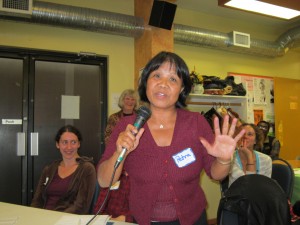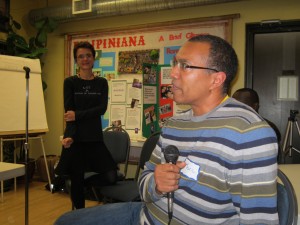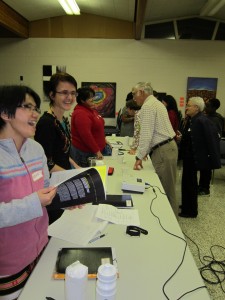Living Courage and strategies for change
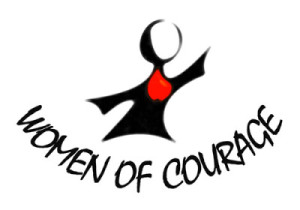
At each public event, participants have been asked the same question as the speakers:
From your experience, what have been the most successful strategies for defending women’s rights and ending violence against women?
The discussion has been both rich and hopeful. The KAIROS action points shared at every event were well received because “they are specific and concrete” , and the ideas shared at these events will be extremely important making KAIROS’ action commitments real for the long term, and to creating a path for specific and ongoing action.
Here’s an attempt to reflect some of these thoughts:
First we need to understand what violence is, and what its roots are. Carol Anne Hilton (Nuu-chah-nulth) underscored a point raised repeatedly by others: violence is a symptom and outcome of poverty, separation, and alienation. Carol Anne’s analysis is that Canada is based on economic apartheid, particularly a separation of Indigenous and non-Indigenous people based on wealth and access to resources. Canada is also based on separateness or apartness (the English meaning of the Afrikaans word “apartheid”. ) She said, “The message is that in order for Canadians to feel comfortable, we must be separate. That is violence.”
Many Indigenous women and men spoke of the multi-generational impact of residential schools as key to understand the origins of violence both in Indigenous communities and in wider Canadian society. Migrant justice advocates spoke of the need to understand the specific vulnerabilities facing migrant workers, and the need to recognise the economic and political violence in the Philippines that drives people to migrate.
Secondly: Over and over, people stressed the need for action together- not alone, and across boundaries of community, country, ethnicity, class and experience. As Carol Anne told us in Victoria: “If we can’t see each other, we can’t solve violence.” Such work together- which demands of us that we break down barriers of separation and fear- would aim to break the reality of fear and isolation experienced by, for example, migrant workers.
Others stressed that we should all be able to agree that violence of any kind is inacceptable. But how to address the reality of violence publicly? Five suggestions emerged:
1) Be honest about the reality of violence. Do not allow it to hide. Annette Cyr suggested at the Regina event that we give violence a language so we can describe it. Carol Anne asked that we recognize violence “as a symptom of all we’ve forgotten, of how we’ve forgotten to be human.” Recognize that sometimes women may have compelling reasons to hide the full extent of violence in the community, as we encountered directly during this cross-Canada visit. Accompaniment and relationship-building are key here, so that women can name the violence on their own terms, and be fully supported when they take the critical and difficult step of breaking the silence.
Others suggested that men and women alike need to be willing to “embarrass the perpetrator.” One group gave example of a “jungle radio” show in Guatemala, where perpetrators of violence are denounced by name every Sunday.
2) Networking online and in person across diversity is key. “Communicate, communicate, communicate.” “We need critical mass in the grassroots by networking. It starts at home and goes from there.”
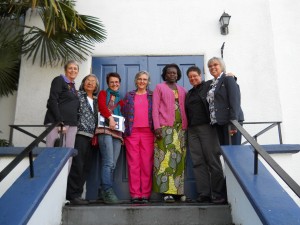
Our hosts at Chemainus United, BC. Gloria and Jill, at left, have been involved in anti-racism dialogue for 20 years as part of their action against violence. They want to see more women and men join this effort.
There are no borders to this issue, though there will also be a need for diverse strategies. Overcoming fear through accompaniment as a means of moving “from victim to survivor” was held up, echoing the work of Sisters in Spirit, migrant justice groups, and Héritiers de la justice in the D.R. Congo. Groups with more power, such as white or middle class women, must be open to being challenged by their sisters.
Also important is “educating for respect”, and it was felt that men must play an especially strong role with other men.
3) As Chantal said, we need to recognize that “Men are not the enemy.” Carol Anne said, “Men must be involved in any solution.” Men can sometimes name violence and be heard in a way that women cannot because “society is trained not to listen to the oppressed.” Men’s efforts to invite and engage other men in the conversation are critical. It was also stressed that male violence against women eliminates male humanity, and that such violence is an expression of male brokenness. Annette Cyr suggested in Regina that we need to “come to see male and female in balance. Otherwise we see each other as enemy, not partner.”
4) Don’t neglect policies and politics. They have a major impact. These can include: provincial changes to policies affecting migrant workers (for example, cracking down on unscrupulous hiring agencies); changing the way police receive reports of violence against women and act on these reports; ensuring adequate funding for prevention of violence with health, education and family services budgets, especially around violence the home and especially when children are at risk.
In particular, social and corporate accountability policies related to mining were raised again and again, since Canadian companies are over-represented on the global resource extraction stage. Continued work to finally secure federal legislation on corporate accountability both here at home and overseas was seen as a major priority, no matter how long the odds. At the same time, we were challenged to use shareholder action to change the practices of mining companies whose operations are displacing communities and destroying traditional economies.
5) Women must be involved in policy making and political decision-making, whether in the community or nationally. From the Philippines to the Congo, from Cree territory to Coast Salish, this was a clear consensus. Sisters in Spirit was upheld as one expression of women striving to break into the decision making process about legal practices that greatly affect Indigenous women. Chantal described two examples from which Canada could learn, and both were drives led by women: the amendment of the Congolese constitution to ensure that 30% minimum of elected national representatives are women; and the passing of a detailed law forbidding sexual violence and outlining its legal consequences. These in turn allowed groups like Héritiers de la justice to find more allies in government, and to use the laws as rights-based platform. HJ has now published a popular or plain language version of the sexual violence law, and is basing all its training on the approach that freedom from violence and freedom for self determination as women are fundamental rights- not extras.
As her closing words in Regina, Cree and Métis sister Annette Cyr said: “I commend you for coming out tonight. Now you have heard. Now you are educated. Now you have an obligation to act.”
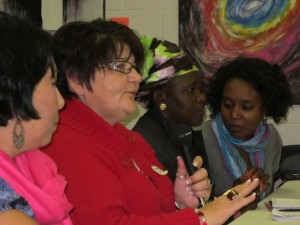
Dr. Shauneen Pete (Cree, SK), Annette Cyr (Cree and Metis, SK), Chantal Bilulu (Congo) and translator Kazia Katende (Canada/Congo) at the Regina public event.
The positive energy -at every event- despite the very difficult topic was a reminder that taking action and having fun go hand in hand.
